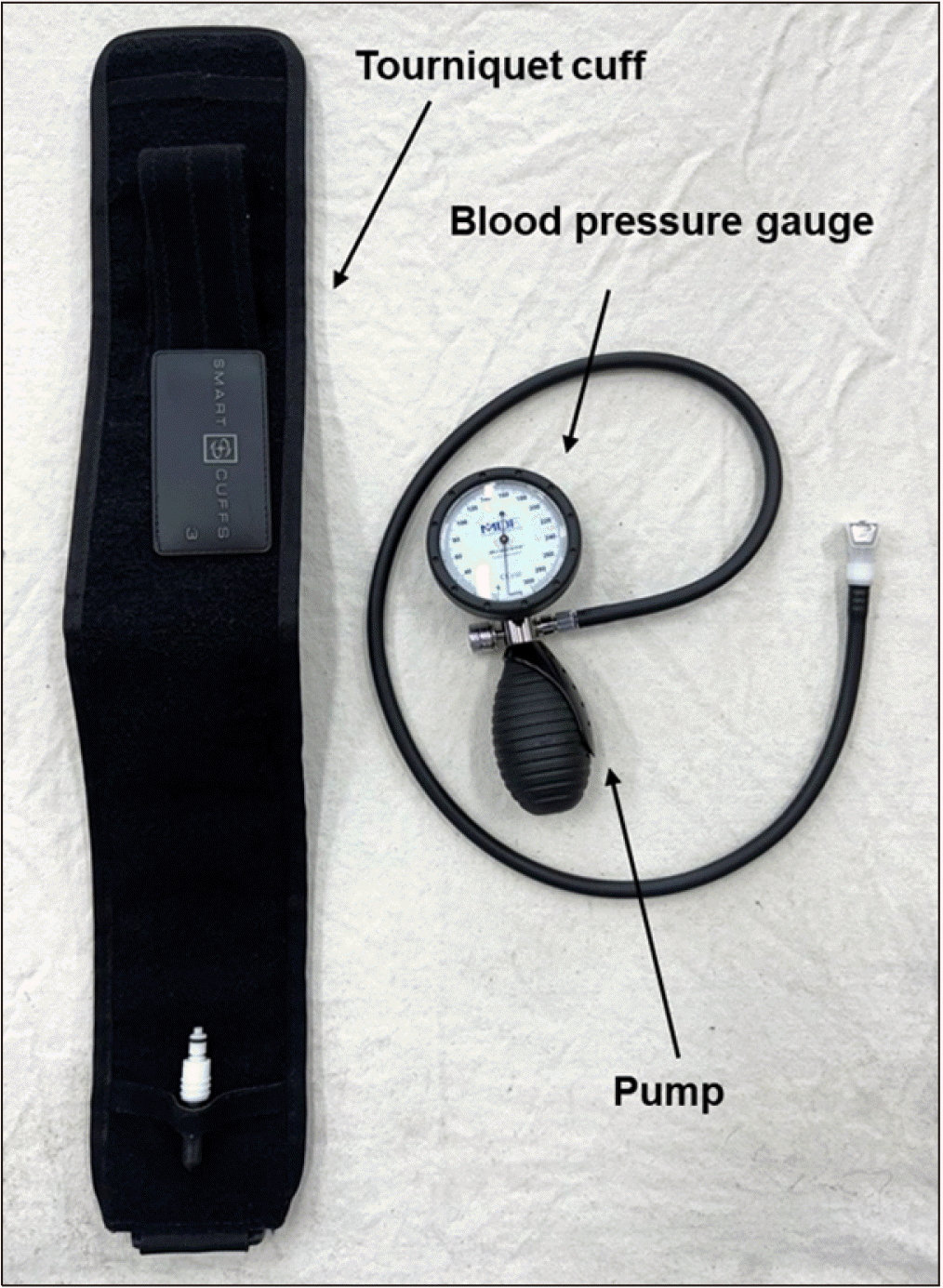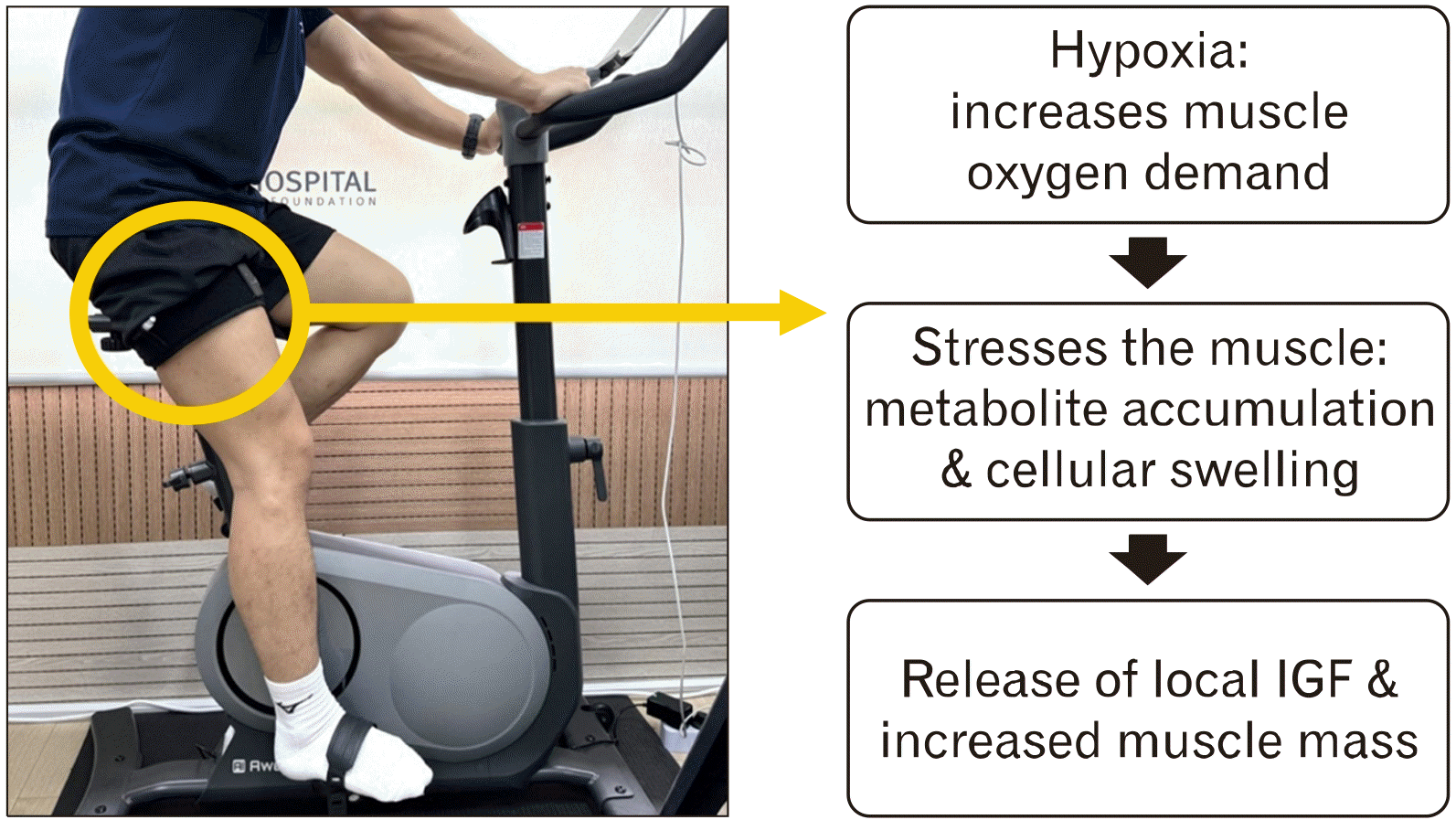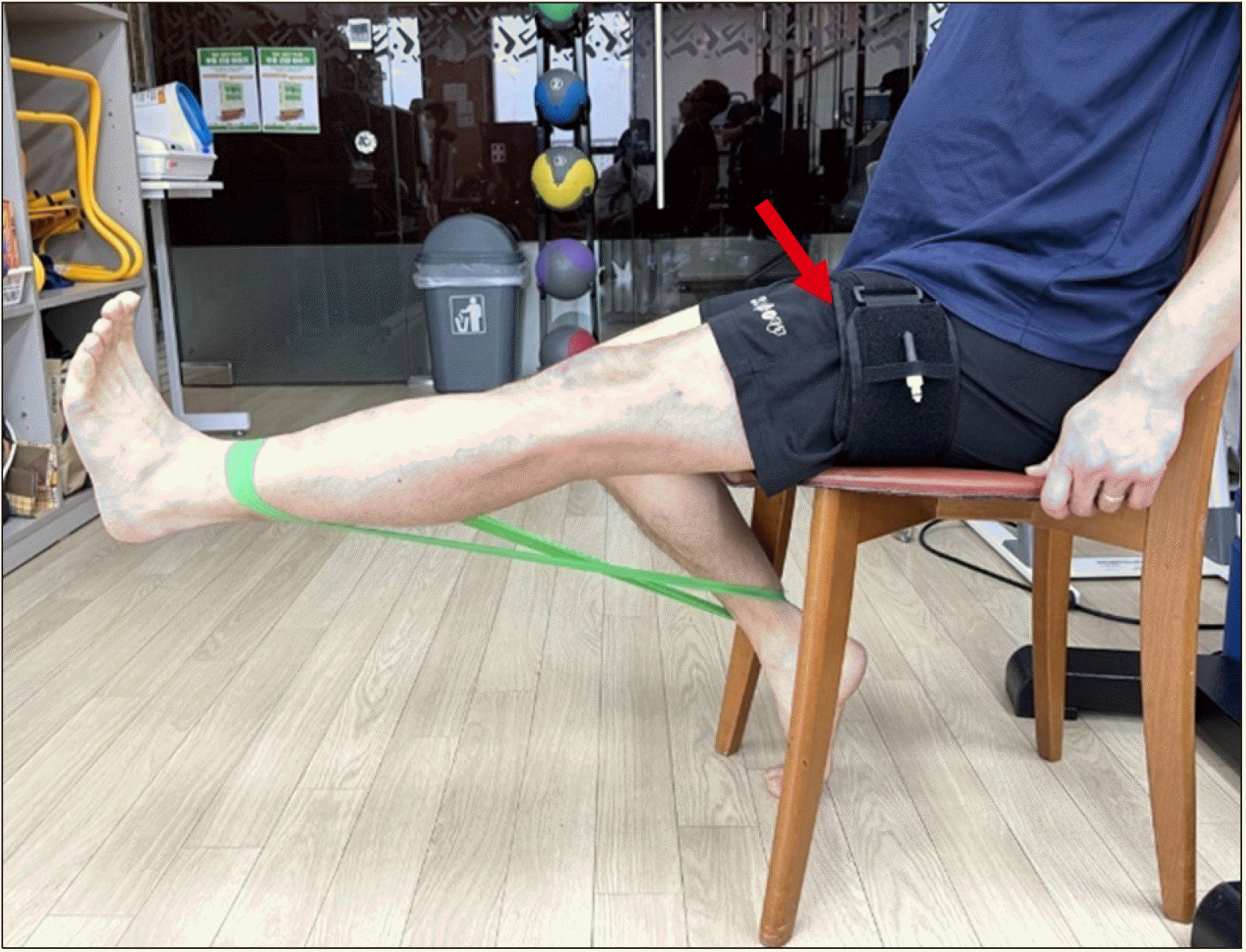서 론
본 론
1. 혈류 제한 운동의 정의 및 원리
 | Fig. 1Blood flow restriction instruments consist of tourniquet cuff, blood pressure gauge, and pump. Tourniquet cuff is used to partially restrict arterial inflow and fully restrict venous outflow during exercise. The blood pressure gauge is used to measure the pressure within the cuff. The pump is used to inflate the tourniquet cuff to the desired pressure. |
2. 전방십자인대 손상 환자에서의 혈류 제한 운동 적용 및 임상 결과 분석
Table 1
| Study | Year | Study design | Method (cuff and pressure) | Outcome |
|---|---|---|---|---|
| Ohta et al.23 | 2003 | RCT |
BFR (n=22): 180 mm Hg, low load
Control (n=22): BFR (−), low load
|
- Operative/contralateral knee extensor power: BFR>control at CC60, CC180, IM60
- CSA ratio of operative/contralateral knee extensor: BFR>control
|
| Lambert et al.22 | 2019 | RCT |
BFR (n=7): 80% LOP 20% 1 RM
Control (n=7): BFR (−) 20% 1 RM
|
- Thigh lean muscle mass decreased more in the control group at week 6 and remained decreased in only the control group at week12
|
| Zargi et al.25 | 2018 | RCT |
BFR (n=10): 150 mm Hg, 14 cm, 30% 1 RM
Control (n=10): 20 mm Hg, 14 cm, 30% 1 RM
|
- Muscle isometric endurance: Shortened significantly in control group at week 4 and returned to preoperative values at week 12, no change in BFR group at any time point
- EMG amplitude increased significantly at week 4 after surgery in BFR group only
- Muscle blood flow increased significantly in BFR group, and decreased in control group at week 4 after surgery
|
| Hughes et al.5 | 2019 | RCT |
BFR (n=12): 80% LOP 11.5 cm, 30% 1 RM
Control (n=12): BFR (−) 70% 1 RM
|
- Isotonic strength: 10 RM strength significantly increased in both limbs with BFR-RT and HL-RT with no group differences
- Isokinetic strength: Significantly greater attenuation of knee extensor peak torque loss at 150°/sec and 300°/sec and knee flexor torque loss at all speeds with BFR-RT
- Muscle morphology: significant increases in muscle thickness with BFR-RT and HL-RT with no group differences
- Significantly greater increases in self-reported function, Y-balance performance and reductions in knee joint pain and effusion with BFR-RT compared to HL-RT
|
| Karampampa et al.26 | 2023 | RCT |
BFR (n=8): 60%−80% LOP 10−20% 1 RM
Control (n=8): BFR (−) 10−20% 1 RM
|
Significant improvements in thigh circumference of the BFR group compared to the control group
Significantly greater attenuation of knee flexors strength deficit at 60°/sec in the BFR group
No statistically significant differences found neither in the strength deficit of the extensor muscles
|
| Jack RA 2nd et al.27 | 2023 | RCT |
BFR (n=17): 80% LOP 20% 1 RM
Control (n=15): BFR (−) 20% 1 RM
|
Only the control group experienced decreases in LE-LM at week 6 and week 12
LE bone mass was decreased only in the control group at week 6 and week 12
Return to sports time was reduced in the BFR group compared with the control group
|
RCT: randomized control trial, SLR: straight leg raise, CC60: angular velocities of 60°/sec, CC180: angular velocities of 180°/sec, IM60: isometric contraction strength at 60° knee flexion, CSA: cross sectional area, LOP: limb occlusion pressure, RM: repeated maximum, RT: resistance training, HL: heavy load, LE: lower extremity, LM: lean mass.
3. 슬관절 골관절염 환자에서의 혈류 제한 운동 적용 및 임상 결과 분석
Table 2
| Study | Year | Study design | Methods (cuff and pressure) | Outcomes |
|---|---|---|---|---|
| Segal et al.30 | 2015 | RCT |
BFR (n=19): 30−200 mm Hg 30% 1 RM
Control (n=22): BFR (−) 30% 1 RM
|
Bilateral leg press 1 RM increased significantly in both the control and the BFR groups with no significant group differences
Significant improvements in isokinetic knee extensor strength in the control group, but not in the BFR group
Significant improvements in KOOS scores in the control group, but not in the BFR group
|
| Segal et al.29 | 2015 | RCT |
BFR (n=19): 30−200 mm Hg 30% 1 RM
Control (n=21): BFR (−) 30% 1 RM
|
Bilateral leg press 1 RM increased significantly in the BFR group than in the control group
Isokinetic knee extensor strength increased significantly more in the BFR group than in the control group
Quadriceps volume with no intergroup difference
No worsening of knee pain in both group with no significant intergroup differences
|
| Bryk et al.8 | 2016 | RCT |
BFR (n=17): 200 mm Hg 30% 1 RM
Control (n=17): pressure not described; 70% 1 RM
|
Higher level of quadriceps strength, function, less pain at 6-week with no inter-group difference
The BFR group with decreased anterior knee discomfort compared to the control group
|
| Ferraz et al.7 | 2018 | RCT |
BFR (LI-RT, n=16): 70% LOP 20−30% 1 RM
1st Control (HI-RT, n=16): BFR (−): 50%−80% 1 RM
2nd Control (LI-RT, n=16): BFR (−) 20%−30% 1 RM
|
Significant 1 RM increase in HI-RT and BFRT but not in LI-RT, with no inter-group difference
Significant quadriceps CSA increase in HI-RT and BFRT but not in LI-RT with no inter-group difference
Significant improvement by TST in HI-RT and BFRT and no significant change by TUG
WOMAC physical function improved in HI-RT and BFRT
WOMAC pain improved in BFRT and LI-RT
|
| Harper et al.6 | 2019 | RCT |
BFR (n=19): [pressure=0.5×SBP+2 (thigh circumference)+5] 20% 1 RM
Control MI-RT (n=16): BFR (−) 60% 1 RM
|
Isokinetic knee extension improvement in both groups of 60°/sec, 90°/sec, and 120°/sec with no significant difference
Function (400 m walk, SPPB, LLFDI) improvement in both groups with no significant difference
Pain (WOMAC and NPRS) improvement in both groups with no significant difference
|
RCT: randomized control trial, RM: repeated maximum, KOOS: Knee injury and Osteoarthritis Outcome Score, LOP: limb occlusion pressure, HI-RT: high-intensity resistance training, BFRT: blood flow restriction training, LI-RT: low-intensity resistance training, CSA: cross-sectional area, TST: timed stands test, TUG: timed up and go test, WOMAC: Western Ontario and McMaster Universities Osteoarthritis Index, SBP: systolic blood pressure, MI-RT: moderate-intensity resistance training, SPPB: short physical performance battery, LLFDI: late life function and disability instrument, NPRS: numeric pain rating scale.
4. 혈류 제한 운동의 적용법
5. 혈류 제한 운동의 안정성
6. 혈류 제한 운동의 통증 완화 효과
7. 저자들의 혈류 제한 운동 적용 방식
 | Fig. 3Algorithm for blood flow restriction training (BFRT) in a similar protocol as reported in the previous review article of Scott et al.48 (Sports Med 2015;45:313-25). |




 PDF
PDF Citation
Citation Print
Print





 XML Download
XML Download